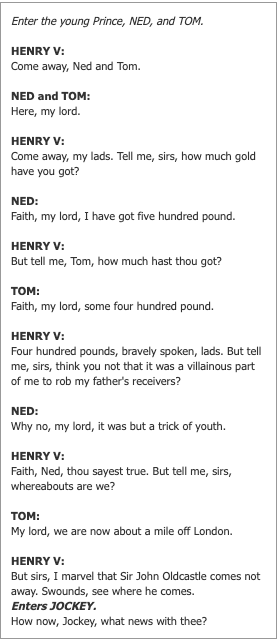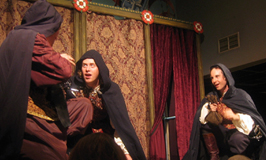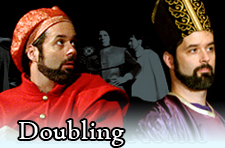Modern Doubling Technique
Break Up the Text into French Scenes

As you will see from the text opposite, the printed edition of Famous Victories simply starts with the stage direction: “Enter the young Prince, Ned and Tom.” There is no indication of act or scene. The fact that early Elizabethan plays do not contain act and scene breaks is an indication that the action is designed to be fluid and not broken by time-consuming set changes. But the person in charge of doubling needs to break the action into discrete units. At each moment in the play, they need to know who is on stage, with whom, and for how long. To create a doubling chart, we need to break the action into French scenes.
The French scene derives from the neo-classical playwrights of France who marked a new scene in their texts every time a character entered or exited the stage. The English practice, which is the one that came to be used in later printed editions of Elizabethan plays, was to mark a scene only when the stage cleared and a new set of characters entered. An English scene therefore might contain several French scenes.
Try it Yourself
Print out a copy of the scene and read through the text marking a new French scene number each time a character enters or exits the stage.
Determine the characters that are on stage in each French scene

This section of text should break down into six French scenes. If you found all six, well done, if not then print out a marked copy of the text and check it against your own.
Using Spreadsheets
Now we need to know which characters are on stage in each French scene. To aid in this the modern director can rely on the miracle of the computer spreadsheet, although it is relatively easy to do the same thing by hand.
Determine the Length of Each French Scene
The chart requires the addition of one more piece of information. We need to know the length of each French scene. This will determine whether the actors have enough time to exit the stage, change costume and re-enter as a new character. In verse text, counting lines is relatively easy, but for prose it is a little harder since the of length prose lines is dependent on the size of the page on which they are printed. We have set our text up so that a line of prose on our page will take roughly the same length of time to speak as a line of verse.
Decide Which Characters Can be Doubled
The person in charge of the doubling needs to establish all the possible doubling options before making decisions. The first rule is that actors cannot play characters that appear in consecutive scenes because they need time to exit, change their costume and re-enter. But if there is one French scene between their exit and subsequent re-entrance, doubling may be possible.
The section of text you have analyzed could be performed by 7 actors even though there are 9 characters. Take a look at the chart and consider which characters could be doubled.
Complete a Doubling Chart for the Entire Play
Since there are 18 lines between the exit of the two receivers and the entrance of John Cobbler and friends then it would be possible to double the receivers with John, Robin or Lawrence. Before we could be sure this would work we would have to complete the doubling chart for the entire play to make sure these characters do not appear in later scenes together or in consecutive scenes.
If you follow the line for the receivers you will see that they do not appear again in the play. The doubling we have discovered is a genuine doubling option because the receivers do not appear on stage simultaneously with John Cobbler and his friends or in consecutive French scenes, but should they be doubled? To make a doubling decision we need to establish all the options and consider important conditional factors.

